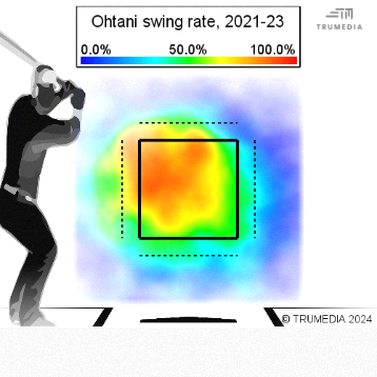
Here's a scary and impossible-sounding thought: Shohei Ohtani, the Los Angeles Dodgers superstar and the reigning American League Most Valuable Player Award winner, is having a career year.
Ohtani entered Monday hitting .352/.423/.667 with 11 home runs and nine stolen bases (on nine tries) through his first 40 games. If the resulting 204 OPS+ sticks -- and yes, we are aware of the statistical concept of regression to the mean -- it would topple his previous career high of 184, established last season en route to signing a 10-year, $700 million pact with the Dodgers. (We feel obligated to note that the present-day value of the contract is significantly less because of unprecedented deferrals.)
We're far enough along in the season now, past the quarter point, that we felt it would be worth our while to dig into Ohtani's game and see what, precisely, is driving his production. Below, we've highlighted three developments worth knowing about.
1. Enhanced approach
We don't think it's controversial to write that the Dodgers have a better reputation for player development and gameplanning than Ohtani's former team, the Angels. With that in mind, is it any surprise to learn that Ohtani has altered his approach this season compared to recent years? Specifically, he's leaned into his elements of his approach that already worked for him.


Take a look at the two heat maps above showing Ohtani's swing rates in counts that had fewer than two strikes. As you can see, he's always had an appetite for swinging at pitches up and in -- he's taken it one step further as a Dodger, upping his aggression level in that area of the zone. He's also laying off borderline pitches that, in the past, would've resulted in a higher offer rate.
Ohtani, in turn, has also improved in various plate discipline metrics. He's chasing outside of the strike zone less often; he's making a career-high amount of contact; and he's even swinging less frequently, both overall and at the first pitch he sees in an at-bat.
That sounds to us like a batter who knows what he's looking for, and who has become more confident in seeking it out while minimizing wasted opportunities.
2. Lifting the ball more often
A player's batted-ball profile is often a function of their approach. To put it in extreme terms, a batter who swings exclusively at pitches down and beneath the zone is far more likely to hit a high frequency of grounders than a batter who swings exclusively at pitches up and above the zone.
With that in mind, it's notable but unsurprising that Ohtani's focus on hitting elevated pitches has corresponded with a shift toward air contact.
Ohtani entered Monday sporting a 33.9% ground-ball percentage this year, which would far and away represent the lowest of his career. (The only other time he finished with fewer than 40% grounders was in 2021, when he checked in at 39.7%.) Ohtani is, relatedly, spraying a greater share of his hardest-hit balls (95 mph and above) in launch-angle window associated with line drives:
- Ohtani, 2021-23: 42.5% between 10-30 degrees
- Ohtani 2024: 50.6% between 10-30 degrees
That's a recipe for a high batting average.
Shohei Ohtani hits his league-leading 15th double of the season 💥 pic.twitter.com/wr2r3axSMR
— MLB (@MLB) May 11, 2024
What's more, though, is that Ohtani is also pulling the ball at the second highest rate of his career. As we've established before, the surest way for a batter to add slugging capacity is to pull balls in the air. It's no wonder, then, why he's on pace to deliver his third career 40-homer season -- and why he's hitting for plenty of average and providing plenty of on-base percentage in the process.
3. Dominating offspeed pitches
We'll close out this article by pointing out that Ohtani has performed uncharacteristically well this season when faced with non-fastballs. Throughout his career, he's always done most of his damage on heaters. In fact, prior to this season, it had been years since he hit even .270 against breaking or offspeed pitches. So far in 2024, Ohtani is batting .333 against fastballs, .370 versus breaking balls, and .385 against offspeed pitches. We can assure you that you read those last marks correctly.
It's not just that Ohtani has improved his results against non-fastballs. Just looking at his tendencies since 2020, he's making more contact and chasing less often than in any other season when he's faced a breaking ball or offspeed pitch. That speaks to a greater improvement in either pitch recognition, gameplan, or some combination thereof.
Shohei Ohtani has homered in back-to-back games! pic.twitter.com/4XMyuB1RZb
— MLB (@MLB) May 5, 2024
It's worth noting the Dodgers as a whole have shown a propensity for beating up on secondary pitches, ranking third among teams with a .246 average and a .441 slugging against non-fastballs. Entering Monday, Los Angeles' lineup also contained three of the 10 highest averages against non-fastballs: Ohtani (third), Will Smith (fourth), and Freddie Freeman (tied for ninth).
Credit the Dodgers' success on non-fastballs to whatever combination of bleeding-edge training and preparation you want. It's part of the reason why they're on schedule to deliver another 100-win season, and it's why Ohtani looks like a souped-up version of his already excellent self.






















